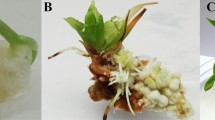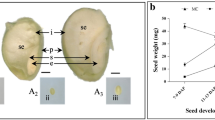Abstract
Fragments of young panicles and immature embryos of different cultivars of grain sorghum were cultured on modified MS and N6 media supplemented with L-asparagine (6.7 mM), L-proline (17.4 mM) and different concentrations of NO -3 , NH +4 and PO 3-4 . The panicle-derived cultures were used in experiments with different nitrogen sources; the influence of PO 3-4 level was studied in embryo-derived and panicle-derived cultures. An increase of the NO -3 and NH +4 levels in the media with amino acids significantly increased induction and growth of embryogenic callus (EC) and its regeneration ability. A new M2 medium, which contained 62.5 mM NH +4 and 72.4 mM NO -3 , exceeded other media which were previously effective for obtaining EC of sorghum. The level of NO -3 and NO -3 /NH +4 ratio in the media supplemented with L-asparagine and L-proline were established to be the critical factors of friable EC formation in sorghum. High level of NH +4 with low level of NO -3 resulted in formation of compact EC, while increase of NO -3 concentration (39.9–82.4 mM) in MS or N6 media favoured proliferation of friable EC in some genotypes. Formation of compact EC in the NH +4 -rich media was accompanied by strong pigmentation of the medium, which was never observed in cultures with friable EC. An increase of the PO 3-4 level (up to 8.8–14.2 mM) was shown to increase the frequency of somatic embryogenesis by 3–4 times, the EC mass by 1.5–2.0 times and its regeneration ability. Media with increased nitrogen or phosphorus could be used for maintenance of sorghum EC for 4–5 passages; for a more prolonged maintenance, their level in the medium should be decreased.
Similar content being viewed by others
References
Armstrong CL& Green CE (1985) Establishment and maintenance of friable, embryogenic maize callus and the involvement of L-proline. Planta 164: 207–214
Bregitzer P, Sommers DA& Rines HW (1989) Development and characterization of friable, embryogenic oat callus. Crop Sci. 29: 798–803
Brettell RIS, Wernicke W& Thomas E (1980) Embryogenesis from cultured immature inflorescences of Sorghum bicolor. Protoplasma 104: 141–148
Chu CC, Wang CC, Sun CS, Hsu C, Yin KG, Chu CY& Bi FY (1975) Establishment of an efficient medium for anther culture of rice through comparative experiments on the nitrogen sources. Scientia Sinica 5: 659–668
Elkonin LA, Tyrnov VS, Sukhanov VM& Ishin AG (1984) Plant regeneration in tissue culture of sorghum. Proc. Acad. Agric. Sci. USSR 4: 7–9
Elkonin LA, Papazyan ND, Tyrnov VS& Ishin AG (1986) Somatic tissue culture of sorghum. Phytohormonal regulation of morphogenesis. Sov. Plant Physiol. 33: 504–512
Elkonin LA, Lopushanskaya RF& Pakhomova NV (1995) Initiation and maintenance of friable, embryogenic callus of sorghum (Sorghum bicolor (L.) Moench) by amino acids. Maydica 40: 153–157
Kaeppler HF& Pedersen JF (1996) Media effects on phenotype of callus cultures initiated from photoperiod-insensitive, elite inbred sorghum lines. Maydica 41: 83–89
Mordhorst AP& Lorz H (1993) Embryogenesis and development of isolated barley (Hordeurn vulgare L.) microspores are influenced by the amount and composition of nitrogen sources in culture media. J. Plant Physiology 142: 485–492
Murashige T& Skoog F (1962) A revised medium for rapid growth and bioassays with tobacco tissue cultures. Physiol. Plant 15: 473–497
Nieds RN (1994) Growth of embryogenic sweet orange callus on media varying in the ratio of nitrate to ammonium nitrogen. Plant Cell Tiss. Org. Cult. 39: 1–5
Songstad DD, Armstrong CL& Petersen WL (1991) AgNO3 increases type II callus production from immature embryos of maize inbred B73 and its derivatives. Plant Cell Rept. 9: 699–702
Stuart DA& Strickland SE (1984) Somatic embryogenesis from cell cultures of Medicago sativa L. II. The interaction of amino acids with ammonium. Plant Sci. Lett. 34: 175–181
Thomas E, King PJ& Potrykus I (1977) Shoot and embryo-like structure formation from cultured tissues of Sorghum bicolor. Naturwiss. 64: 587
Trigiano RN& Conger BV (1987) Regulation of growth and somatic embryogenesis by proline and serine in suspension cultures of Dactilis glomerata L. J. Plant Physiol. 130: 49–55
Welter ME, Clayton DS, Miller MA& Petolino JF (1995) Morphotypes of friable embryogenic maize callus. Plant Cell Rept. 14: 725–729
Wetherall DF& Dougall DK (1976) Sources of nitrogen supporting growth and embryogenesis in cultured wild carrot tissue. Plant Physiology 37: 97–103
Vain P, Yean H& Flament P (1989) Enhancement of production and regeneration of embryogenic type II callus in Zea mays L. by AgNO3. Plant Cell Tiss. Org. Cult. 18: 143–151
Vasil V& Vasil 1K (1986) Plant regeneration from friable embryogenic callus and cell suspension cultures of Zea mays L. J. Plant Physiol. 124: 399–408
Author information
Authors and Affiliations
Rights and permissions
About this article
Cite this article
Elkonin, L.A., Pakhomova, N.V. Influence of nitrogen and phosphorus on induction embryogenic callus of sorghum. Plant Cell, Tissue and Organ Culture 61, 115–123 (2000). https://doi.org/10.1023/A:1006472418218
Issue Date:
DOI: https://doi.org/10.1023/A:1006472418218




